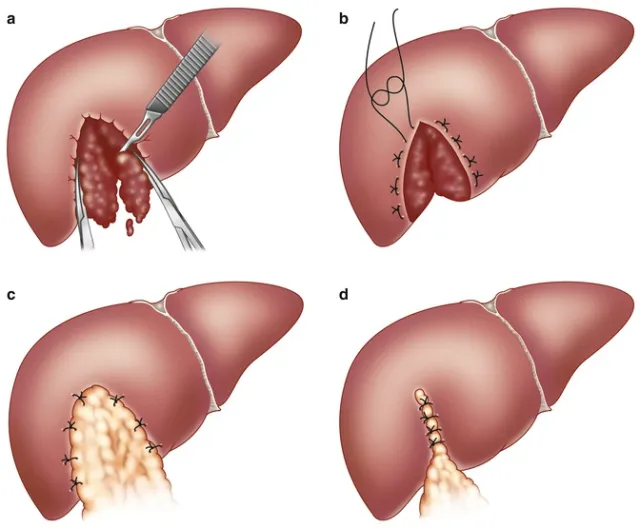Liver Injury Packing / Hepatorrhaphy
Liver injury packing and hepatorrhaphy are surgical interventions used to control bleeding and repair damage to the liver, commonly caused by traumatic injury. The liver, being a highly vascular organ, can bleed profusely when injured. Quick surgical intervention is often necessary to save the patient’s life.
Liver Packing involves placing sterile surgical pads or sponges around or within the liver to compress bleeding vessels and control hemorrhage.
Hepatorrhaphy is the direct suturing or stitching of liver lacerations to stop bleeding and restore anatomical integrity.

Symptoms of Liver Injury
Liver injuries can present with various symptoms depending on the severity. Common signs include:
- Abdominal pain, especially in the upper right quadrant
- Swelling or distension in the abdomen
- Internal bleeding (may cause signs of shock)
- Low blood pressure or rapid heart rate
- Pale, clammy skin
- Nausea or vomiting
- Referred pain to the right shoulder
- Altered consciousness in severe cases due to blood loss
Immediate medical evaluation is crucial if liver injury is suspected after trauma.
Procedure / Treatment
1. Initial Assessment
Clinical examination and imaging (CT scan or ultrasound)
Stabilization of the patient with IV fluids and blood transfusion if needed
2. Surgical Intervention
If non-operative management is not possible, emergency surgery is performed.
Liver Packing: Surgical sponges are placed to control diffuse bleeding. Packs are often removed 24-48 hours later in a second-look surgery.
Hepatorrhaphy: Suturing is used to close lacerations or seal bleeding vessels. Sometimes tissue glue or hemostatic agents are applied.
3. Postoperative Care
Intensive monitoring in ICU
Antibiotics to prevent infection
Repeat imaging to check healing
Gradual return to activity with dietary adjustments
Types of Liver Injuries Managed
Grade I-II (Minor): Small lacerations or hematomas; may be managed conservatively.
Grade III-V (Severe): Large lacerations, deep hematomas, or active bleeding requiring surgical repair or packing.
Penetrating Injuries: From gunshots or stab wounds.
Blunt Trauma: Often due to road accidents or falls.
Prevention of Liver Injury
While traumatic injuries are often unpredictable, preventive measures can reduce the risk:
- Wear seat belts while driving
- Use protective gear during sports or high-risk activities
- Avoid alcohol before operating vehicles or machinery
- Ensure safe home and work environments to prevent falls
Benefits of Liver Packing / Hepatorrhaphy
- Immediate control of life-threatening hemorrhage
- Prevents further liver tissue damage
- Increases survival chances in severe trauma
- Restores liver function and anatomy
- Reduces risk of complications like peritonitis or bile leaks
